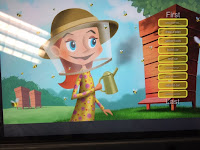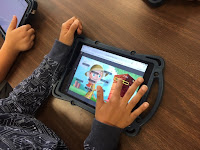The amount was amazing but shopping for robotic items isn't on the cheap side. This led me to do quite a bit of research as to the best way to use the money. The tools had to be inventive, user-friendly for all ages, adaptable, reuseable and can be withstand the creative mind of elementary engineers. Makey Makey proved to be a great fit for this endeavor.
Watching webinars and reading manuals was a great place to start, but working with it alongside an experienced creator is where the learning took a major turn. I reached out to my IFT (Instructional Facilitator of Technology) community and learned that colleague was well connected with the head trainer of Makey Makey! Colleen Graves
After the successful training, it was time to translate this to the class. Students were introduced, briefly, to the tool. They were given Play-doh and a laptop and navigated to a website with a piano. Students worked feverishly to play music touching the Play-doh! You can read more about the experience here.
After succeeding with this skill, Mrs. Gratz came with to use Makey Makey to light up holiday trees during the grade level's winter concert.
Makey Makey was brought to her room, students learned how to use and they began coding. Through the process students connected the robotic tool to low voltage Christmas lights strands. They cut apart the battery pack and used the power of the tool and computer to light the tree. Three head engineers, all 3rd grade students, were in charge or ensuring the trees were all the same height, alligator clips attached to the correct places, copper tape cut to the correct length and each strand of light could shine to show their own color. When complete, 12 different trees and lights were connected correctly.
The final step was to make the trees glow brilliantly to match the song they and their classmates were singing. The music was taught in their specials class by our fabulous teacher, Mr. Pennix. His teachings were brought to the class and they paired the lights with recording shared by him. Below is a clip of their performance.
The story doesn't end here. After sharing the concert with Colleen, it was requested that the students document directions for how it was done. Makey Makey has a section of free resources for their users where teachers can locate instructional guides to build a variety of things. Mrs. Gratz had her students created a PDF and video that explains how other users can replicate this same project.


















